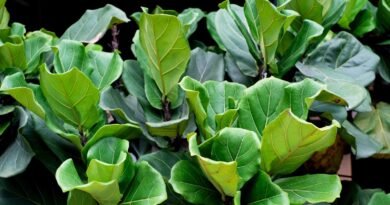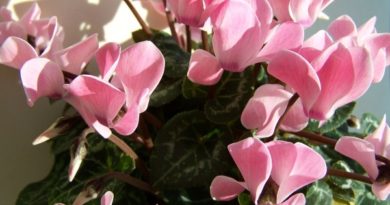Where Not to Put Your Houseplants: 17 Spots to Avoid
All living things have non-negotiables. Healthy food, good surf, and morning coffee are mine. For houseplants, access to water, light, and warm temperatures usually fit the bill. If their needs are not met, they can lose their vitality quickly.
That’s why placing your houseplants in the right locations matters. They’ll stay healthier and give you more radiant blooms and foliage in their preferred space.
To help you decide where not to put your houseplants this year, keep reading below. Keep your houseplants away from these 17 indoor locations.
Dura Cotta Hanging Basket


Ideal for trailing plants, the Dura Cotta Hanging Basket features a built-in reservoir that holds excess water, ensuring your plant’s roots stay consistently hydrated. Assembly is effortless with included clips and a macrame cord, allowing you to easily suspend the planter from a wall bracket or ceiling.
Dark Spaces


All plants need at least some light. By depriving them of it, you’re almost guaranteed to see them quickly die. Dark spaces are at the top of the list for places where not to put your houseplants.
Some species can adapt to low light conditions, such as ZZ plants. However, they still need filtered light throughout the day. As long as there’s a window or enough indoor artificial light, they will be fine.
Avoid placing any species in a dark basement, closet, or empty room. If the space is dark for most of the day and night, it’s not a good location.
Near Cold Drafts


Even in the depths of winter, we can get colorful bloomers and tropical-looking climbers to thrive indoors. As long as the temperature remains constant and there’s enough light, you’ll have very few problems.
However, areas of your home with cold drafts can stress your indoor plants. Most species are native to warm climates. Sudden temperature drops will challenge even the hardiest species.
Avoid spaces such as entryways, large windows, or areas near open doors. These are spaces that can get cold suddenly. They are not good areas for your houseplants to grow.
Close to Air-Conditioners


Air conditioning can be essential in the summer. In places such as Phoenix and Orlando, it would be unbearable to live without them. As helpful as they are for keeping our living spaces cool, they can send temperatures and humidity levels plummeting.
Indoor varieties thrive with consistent temperatures and humidity levels. If their growing conditions change too suddenly, some species can show signs of stress.
Move humidity-loving species away from air-conditioning units. Species such as aloe vera that are native to dry regions can handle the dry and cool air that air conditioners create. If you need your air on and live in a small space, use a humidifier to keep the humidity levels high.
Near a Heater


Like cold drafts, too much hot air can change the temperature too suddenly. Most species prefer warm yet stable temperatures between 65 and 75°F (18-24°C). If the temperature goes above that, it can shock and dehydrate them.
Keep your containers away from heaters, radiators, space heaters, and warm air vents. Areas in the middle of the room or in elevated locations like tables and bookshelves are ideal.
Outdoors in the Cold


Many of us love moving our houseplants outdoors in the summer. However, wait until the nighttime lows are above 50°F (10°C). Most of our favorite indoor growers are from tropical and subtropical regions.
Plants such as Monstera, Peace Lily, and Pothos will succumb to the cold very quickly. If you move them outside too early, they’ll show signs of stress from the cold.
Wait until the low temperatures are pleasantly above 50°F (10°C) before moving your containers outdoors. Even if the daytime highs are pleasant, a sudden drop in temperature can be dangerous for your delicate houseplants.
Outdoors Without Acclimating


Indoor plants have a cozy life. Constant temperatures, dependable moisture and humidity, and a stable amount of light. Life outdoors isn’t as comfortable. Light changes from full sun to cloudy filtered light and harsh wind and changing temperatures are challenging to plants.
To give your favorite indoor bloomers a fighting shot, acclimate them to their new environment. When the temperatures are warm enough in spring or early summer, move them to a shady location inside. When the temperatures drop, bring them back inside.
Repeat this over several days and gradually expose them to more sunlight. After about two weeks, they’ll be ready for their new home outdoors.
Directly in the Sun


After acclimating your plants to the outdoors, be mindful of where you place their containers or plant them. Many popular indoor species, such as pothos, need filtered light. Some species, such as aloe, snake plant, and papyrus, love full sun to partial shade.
Moving shade-loving plants into the sun can be catastrophic. Move these species under the shade and give them more time to adjust to the outdoors.
Even sun-loving species need to acclimate to the outdoors. Once they’re ready, you can place them under the sun. Keep watching them and checking for sun damage as they grow.
Near Infested or Diseased Plants


One of the worst places to put your houseplants is near infested or diseased plants. Sometimes, we don’t realize our plant has an issue. By putting new arrivals or old favorites near infested plants, we’re giving these critters a new host to feed on.
Pests and pathogens such as mealybugs, aphids, scales, and powdery mildew can sometimes find their way to our indoor growers. They can hitch a ride on almost anything from pruners to produce. For species such as whiteflies, indoor conditions are perfect and before you know it, you’ll have swarms to deal with.
If you have an infested or diseased houseplant, quarantine it in another location. You’ll have a better shot at isolating the pathogens or pests and preventing them from spreading. This way, you’ll treat one plant instead of the entire group.
On Top of the Fridge


Refrigerators are great spaces to put art, decorations, or kitchen appliances. They’re not good places to put our plants.
Refrigerators work by moving warm air inside it through a refrigerant and releasing warm, dry air outside of it. This warm, dry air keeps the humidity levels around it low.
Besides being a low-humidity space, the tops of refrigerators have very low light. Most species will tolerate a low-humidity and low-light space.
In Bright Areas


While houseplants love bright, indirect light, too much could be harmful. If you have a south-facing window that gets plenty of direct sunlight, it may not be good for many species.
In these well-lit corners, grow species that need a lot of light. These include succulents, ponytail palms, citrus, and rubber trees. Shade-loving varieties should go in shadier locations.
In Lonely Corners


Corners can be aesthetically pleasing when you decorate them with a touch of greenery. However, most plants won’t appreciate the low light and constricted conditions.
Plants that prefer bright, indirect light will not thrive in corners. These spaces are usually away from windows and are some of the darkest spaces in our homes.
If you’re insistent on having plants fill the lonely corner spaces, try shade-loving varieties instead. Ferns, spider plants, ZZ plants, and snake plants are good alternatives for corner spaces.
Crowded Near Other Plants


Overcrowding leads to all kinds of problems. Sure, plants look cool and jungle-like when they’re bunched up together. However, pests and diseases can easily travel between them. They’ll also block each others’ access to light.
Space your houseplants at least one or two feet from each other. For larger species, move them even further to stop their broad foliage from blocking the light.
Near Electronics


Houseplants may be safe from electronics, but the same can’t be said in reverse. Indoor plants need lots of water and if you’re like me, spills are inevitable. When this happens, your electronics may be in danger.
Keep your plants away from valuable electronics that water will damage. Even falling leaves could pose a fire risk if they land near exposed wires.
Having plants near your workspace is important. Several studies link them with improved mental health and work performance. Consider growing them on shelves away from your desk or expensive gadgets. You’ll still get their benefits without risking harmful water spills.
Close to Fire


There’s nothing better than having a fireplace roasting inside during cold nights. As cozy as it is, it’s not the best place to put your houseplants.
Fire creates heat and lowers the humidity levels around it. The sudden bursts of dry heat will stress out most varieties. Over time, they’ll start showing signs of temperature stress, such as leaf curling, dropping leaves, and wilting.
Near Pets


Our beloved indoor varieties can sometimes be poisonous. All too often, our pets end up in the vet’s office after nibbling on leaves and branches.
Poisonous species include calla lily, dumb canes, and iris. They contain many toxic compounds that will wreak havoc in our furry friends’ digestive systems.
When you bring a new houseplant home, check its toxicity level online. If they’re toxic, place them away from areas where pets like to hang out.
On the Floor


While houseplants can survive on the floor, they’ll do much better off the ground. Cold drafts of air stay low to the ground. If a door opens in winter, all that cold air will move along the floor and stress out your low-lying plants.
Another risk of having containers on the ground is tripping over them. Spilling over disrupts their roots and can stress them out. When this happens, they can show signs of stress, such as losing their leaves, stunted growth, or wilting.
Keep your houseplants on tables, cabinets, or raised containers. Hanging baskets are also wonderful places for species such as ivies, ferns, and succulents.
In Crowded Spaces


Crowded areas with a lot of foot traffic can be dangerous spaces to put your containers in. Plants will be stressed if they’re kicked over. We’ve all seen the results of a pot that falls on the ground.
Besides the mess, these conditions will harm your plants over time. Hallways, kitchens, and living rooms are especially prone to foot traffic and accidents.
Keep your plants on elevated surfaces. Keep them spaced far apart and secure them closer to the wall.





